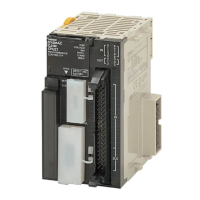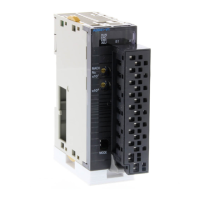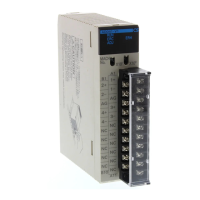106
ample of how DIFU(13) can be used to ensure that CMP(20) is executed only
once each time the desired execution condition goes ON.
00000
CMP(20)
HR 10
DM 0000
Diagram A
22500
CMP(20)
HR 10
DM 0000
Diagram B
DIFU(13) 22500
00000
Address Instruction Operands
00000 LD 00000
00001 CMP(20)
HR 10
DM 0000
Address Instruction Operands
00000 LD 00000
00001 DIFU(13) 22500
00002 LD 22500
00003 CMP(20)
HR 10
DM 0000
Although a differentiated form of MOV(21) is available, the following diagram
would be very complicated to draw using it because only one of the condi-
tions determining the execution condition for MOV(21) requires differentiated
treatment.
22500
MOV(21)
HR 10
DM 0000
DIFU(13) 22500
00000
00001 00002 00003
00004 00005
Address Instruction Operands
00000 LD 00000
00001 DIFU(13) 22500
00002 LD 22500
00003 LD 00001
00004 AND NOT 00002
00005 AND NOT 00003
00006 OR LD ---
00007 LD 00004
00008 AND NOT 00005
00009 OR LD ---
00010 MOV(21)
HR 10
DM 0000
5-7-3 KEEP – KEEP(11)
B: Bit
IR, AR, HR, LR
Ladder Symbol Operand Data Areas
S
R
KEEP(11)
B
Any output bit can generally be used in only one instruction that controls its
status. Refer to 3-3 IR Area for details.
KEEP(11) is used to maintain the status of the designated bit based on two
execution conditions. These execution conditions are labeled S and R. S is
Example 2:
Simplifying Programming
Limitations
Description
Bit Control Instructions Section 5-7

